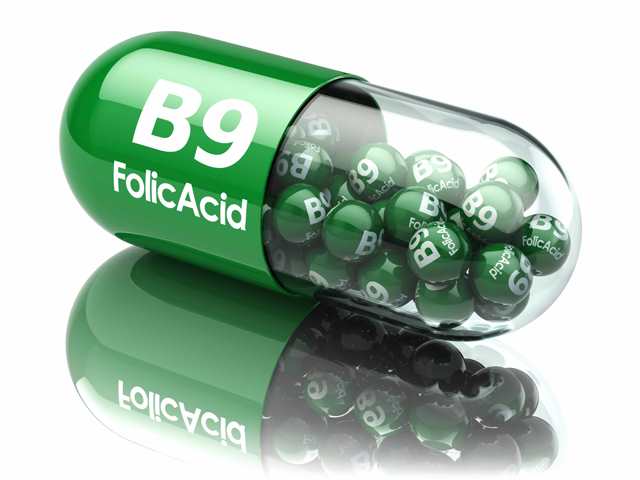Our bodies need #folate – an essential nutrient – to develop and grow. Folate, also called vitamin B9, can’t be stored in large amounts by our bodies, so we need to get it from the foods we eat. Folate is naturally found in leafy green vegetables, root vegetables, and legumes (to mention only a few sources). A synthetic form of folate, called folic acid, can also be taken as a dietary supplement or added to common foods to ensure that we aren’t lacking this important nutrient. In fact, Canada has fortified wheat flour with folic acid since 1998, making many of the foods we eat every day such as bread, cereal, and pasta good sources of folate.
Not having enough folate in your body can lead to some serious medical conditions. In one of these, called anemia, the number of red blood cells is lower than normal so your body isn’t getting as much oxygen as it should. This can make you feel tired and out of breath. For pregnant women, having enough folate is especially important to help prevent birth defects including neural tube defects affecting the brain, spine, and spinal cord; heart defects; and cleft lip and palate. Some medications such as methotrexate and some antibiotics as well as medical conditions like inflammatory bowel disease, alcohol dependency, and celiac disease can put you at a higher risk of folate deficiency.
MORE: THERAPY FOR PTSD – DRUGS, COUNSELLING AND YOGA?
If a folate deficiency is suspected, blood tests can be ordered to check folate levels. There are two different tests available. One measures the amount of folate in the serum or fluid part of your blood – called serum folate testing. A second measures the amount of folate inside your red blood cells – called red blood cell folate testing. The serum folate test is easier to perform, but the results can be influenced by your recent dietary intake of folate. Red blood cell folate testing is technically more difficult and therefore more costly, but can provide a more accurate measure of folate in your body over the long-term. If you do have a folate deficiency, it can usually be easily treated with daily folic acid supplements.
The availability of two different tests makes decisions about measuring the amount of folate in your body a little more difficult. Which test should be ordered? To make things even more complicated, some health care professionals feel that because folate and folic acid supplementation are so common in our diets, the risk of being deficient is really low and we don’t need to test folate levels at all. In this case, if a deficiency is suspected or you are at increased risk of a deficiency, they may recommend simply taking folic acid supplements without testing first. There are very few risks to supplementing with folic acid and it likely costs significantly less than testing folate levels.
MORE: TESTING FOR HELICOBACTER PYLORI: CAN STOOL PROVIDE THE ANSWER
To help sort out this confusion about testing folate levels, the medical community turned to #CADTH — an independent agency that finds, assesses, and summarizes the research on drugs, medical devices, tests, and procedures — to find out what the evidence says.
When CADTH searched for the evidence on folate testing, they found 12 relevant publications – one systematic review, two non-randomized studies, and nine evidence-based guidelines. The evidence, although very limited, did not seem to show any benefit to patients when their folate levels were tested. In fact, the evidence found that testing identifies very few cases of folate deficiency and doesn’t change how folate deficiency is treated. And whether folate testing offered good value for the costs involved was unclear. In general, the guidelines did recommend folate testing for patients with health conditions that can lead to folate deficiency, but these recommendations were based mostly on expert opinion and lower quality evidence. If testing for folate deficiency, the guidelines recommended serum folate testing over red blood cell folate tests. Overall, there is little evidence to support routine folate testing in Canada.
So what does all this mean for health care professionals, their patients, and the health care system? The evidence, together with very low rates of folate deficiency in Canada, indicates that testing of folate levels may not be warranted. And in fact, some hospitals and health regions in Canada have already restricted the availability of folate testing (or eliminated it altogether). Testing may be useful for some patients, especially those who may not respond well to treatment, but it would appear that serum folate testing – the simpler and less costly test – would then be adequate.
Knowing the evidence on folate testing can help with making important decisions in Canadian health care. In this case, limiting or eliminating folate testing, and choosing the least costly testing option for those who are tested, could offer cost savings to the health care system without affecting the health of patients.
If you would like to learn more about CADTH and the evidence it has to offer to help guide healthcare decisions in Canada, please visit www.cadth.ca, follow us on Twitter: @CADTH_ACMTS, or talk to our Liaison Officer in your region: www.cadth.ca/contact-us/liaison-officers.




